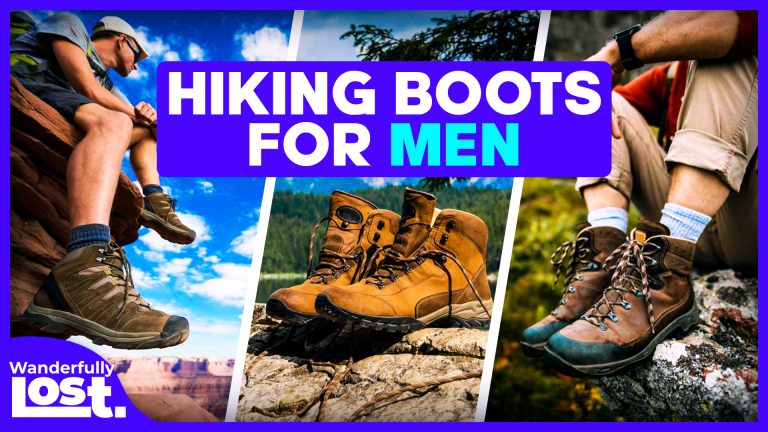Hiking compels us to ditch the comforts of modern living and go on a journey that invokes a minimalistic lifestyle, carrying only what we need on our journeys to see the breathtaking outdoors.
Whereas minimalistic might mean working with less, when it comes to comfort, modern travelers know the right equipment goes a long way in helping you check off that bucket list. As a foundation of your outdoor escapades, sturdy and comfortable hiking boots should be at the top of your shopping list.
Whether going on a short or multi-day hike, you need good hiking boots to protect your feet and steady your ankles. We have compiled a list of seven best hiking boots for men to help you conquer the outdoors.
Before you get lost in our blog, be sure to browse our Wanderful Storefront for all our favorite travel products, gear and must haves!
This post includes affiliate links. It’s super important for us to be transparent with our Wanderers! If you click on one, we may receive a small, but wanderful commission at no extra cost to you. Thanks for WANDERING with us!
1. Salomon X Ultra 4 Mid Gore-tex Hiking Boots
Material: Polyurethane-coated leather/textile
Waterproofing: Yes
Item weight: 14.99 Ounces
Price: $165+
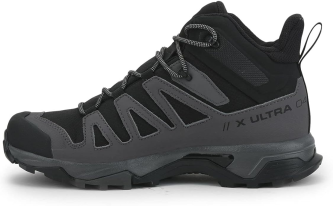
Salomon’s X Ultra 4 Mid GTX hiking boot is perfect for hikers who want comfy, long-lasting boots. They are great for short or long hikes, offering ankle support and soft cushioning. The boot’s upper part is made from tough polyurethane-coated leather and synthetic fabric, which keeps it solid yet breathable.
It also has a protective rubber cap at the front to shield your toes during rocky climbs. What makes these boots special is their waterproof Gore-Tex lining, keeping your feet dry, even in deep snow. The bottom of the boot has Salomon’s Contagrip sole, giving you a good grip on most surfaces, though it is not ideal on ice.
Salomon’s X Ultra 4 Mid GTX is a solid choice for hikers who need tough, supportive boots that can handle various trail conditions, so you can focus on enjoying your outdoor adventures without worrying about your feet.
Pros
- Light design
- Comfortable padding and ankle support
- Waterproof
Cons
- Contagrip not effective in snowy conditions
2. Merrell Men’s Moab 3 Mid Waterproof Hiking Boot
Material: Pigskin leather/mesh
Waterproofing: Yes
Item weight: 2.55 Pounds
Price: $73+
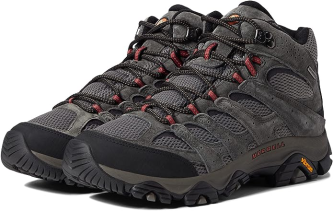
The Moab 3 has a supportive arch, reinforced heel, and a cushioned EVA footbed to boost comfort and security. They are great for hikers seeking arch support but may not offer the natural footbed some prefer nowadays.
The updated Moab 3 boasts a more supportive insole, a cozier midsole, and an improved Vibram outsole for better grip and confidence. They have also been made with sustainable materials, making them the most eco-friendly version yet.
The breathable mesh upper, strengthened with suede leather, enhances durability. Despite the mesh for breathability, these shoes stay waterproof even through river crossings. Moab 3 boots are simple and sturdy, perfect for those who like a classic look. We also appreciate how easy they are to lace up.
Pros
- Pocket-friendly
- Fully waterproof
- Comfortable
Cons
- Slightly bulkier than most hiking boots on this list
3. Xero Shoes Men’s Xcursion Fusion
Material: Polyester and mesh
Waterproofing: Yes
Item weight: 2.12 Pounds
Price: $165
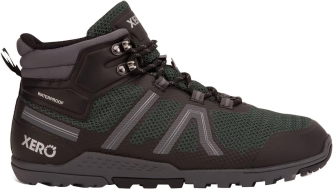
The Xero Shoes Xcursion Fusion hiking boot is super lightweight yet tough and protective. It’s an excellent choice if you want durable and light boots. These boots feel incredibly light due to their simple design and flexible sole, a common feature in Xero Shoes’ super lightweight footwear.
The upper part of the boot combines synthetic mesh with strong TPU overlays for support. The sole has 10 millimeters of cushioning and a tough tread pattern with 3.5-millimeter lugs for traction. Also, these boots offer waterproofing thanks to the sealed inner booties, water-resistant membranes, and gusseted tongues to help keep your feet dry.
These boots are “zero-drop,” meaning they don’t lift your heel higher than the rest of your foot. While this style isn’t for everyone, it can help strengthen foot muscles over time, improving balance, agility, and posture.
Pros
- Waterproof
- Zero-drop feature to increase agility
- Lightweight
Cons
- Less cushioning compared to other boots on this list
4. La Sportiva Nucleo High II GTX
Material: Nubuck leather
Waterproofing: Yes
Item weight: 2.91 Pounds
Price: $150+
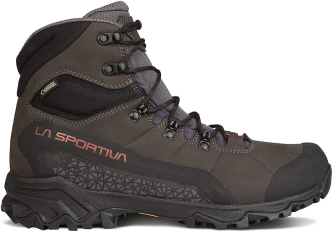
Keep your feet dry with La Sportiva’s Nucleo High II GTX hiking boots. The boots have a Gore-Tex Surround lining and an upper part made of nubuck leather to keep water out and dry quickly if they get wet.
Plus, the gusseted tongue feature attached to the sides and bottom of the shoe helps keep out water, dirt, and debris. The base of these boots is made of Vibram Nano XS-Trek compound that gives you a good grip, whether you are walking through a river or deep snow.
Pros
- Keeps water and dirt out
- Good grip in slippery areas
- Removable gusseted tongue
Cons
- Bulky
- No mesh for breathing
5. Altra Lone Peak All-Wthr Mid 2
Material: Textile Fabric
Waterproofing: Yes
Item weight: 1.88 Pounds
Price: $132+
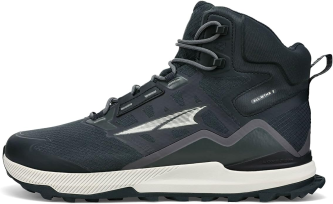
The Altra Lone Peak All-Wthr Mid 2 is an excellent choice if you have wide feet and often struggle to find hiking boots that fit just right. These boots are designed with Altra’s special FootShape toe box, which gives your toes plenty of wiggle room to spread out naturally as you walk. That helps prevent blistering and hot spots, common with boots that don’t fit well.
Plus, the Lone Peak All-Wthr Mid also has a wide design that works well for different foot shapes and sizes, so even if your feet are wider than usual, these boots will still fit comfortably. The upper part of the boot is made from waterproof and breathable materials, keeping your feet dry and comfy.
The mid-height cuff adds extra support to your ankles. The boot’s outsole is designed for excellent traction on various surfaces, including wet and slippery terrain. The lugs on the sole are placed strategically to improve grip. Altra’s DuraTread rubber is among the best, right up there with various Vibram rubbers.
Pros
- It has a great grip on slippery terrain
- It has a spacious toe box to support wider feet
- Lightweight
Cons
- The waterproof feature fades quickly, as per online reviews
Altra Lone Peak starting at $132
6. Scarpa Zodiac Plus GTX
Material: Suede leather
Waterproofing: Yes
Item weight: 1.25 Pounds
Price: $299+
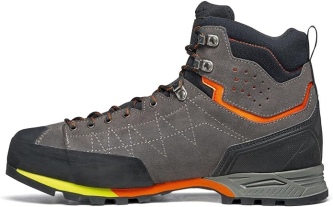
The Scarpa Zodiac Plus GTX is a backpacking boot that provides strong support for all your outdoor needs. It’s great for carrying a heavy backpack over tough mountain terrain. It’s lighter than traditional mountaineering boots but still sturdy enough to support you on and off the trail during iconic hikes like the Sierra High Route.
This boot’s tongue is part of the suede leather upper, almost like a sock. That helps prevent bunching up and hotspots. Plus, it has a Gore-Tex membrane that keeps your feet dry and protected, whether walking through rocky terrain or snowy fields. Taking inspiration from Scarpa’s other climbing shoes, this boot has a lacing system that goes toward your toes, allowing you to get a precise fit.
A rubber rand also shields the upper part of the boot from rough impacts, making it last longer. The midsole is made of four types of foam for cushioning and support where you need it most. Thanks to its Vibram outsole, this design keeps your feet firmly planted on the ground, offering stability and speed whether climbing over rocks or tackling steep slopes.
Pros
- Supports multipurpose outdoor escapades
- Steady grip
- Sturdy
Cons
- Stiffer than typical hiking shoes
- Expensive when compared to other hiking boots on this list
Scarpa Zodiac Plus starting at $299
7. KEEN Targhee III Waterproof Mid
Material: Leather
Waterproofing: Yes
Item weight: 1.5 Pounds
Price: $175
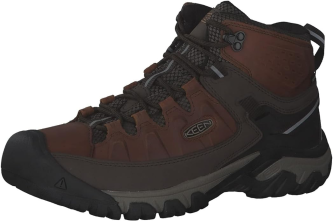
The Targhee III is a versatile hiking boot suitable for all outdoor enthusiasts. It weighs just over 1.5 pounds per pair, which is relatively light for a sturdy boot. It’s waterproof, thanks to KEEN’s special KEEN.DRY technology. Most users find it very comfortable from the start, though it may not be the best choice for those with narrow feet.
These boots will keep your feet happy by providing excellent traction and, most importantly, preventing blisters. If you compare it to the Salomon X Ultra 4 Mid GTX, they are pretty similar in terms of support, weight, and appearance. The main difference is that the Targhee III has more room inside, making it a better choice for people with wider feet or who prefer a roomier fit.
Both of these boots are among the best for hiking and exploring the outdoors, and they should last for many years. The Targhee III is especially appealing if you want a reasonably priced, lightweight option without compromising on durability.
Pros
- Supports wider feet
- Good price point
- Great grip
Cons
- Waterproofing is not as effective as others on this list
- Not suitable for narrow feet
How to choose hiking boots
Picking the right hiking boots is entirely a personal endeavor. We all have different foot shapes and trail needs, so it’s important to do some research and try out different boots to find the ones that fit and offer you the best functionality.
Sturdy and stable boots are not as comfortable as regular shoes, mainly because you wear them for long hours in a day. That means you need a boot that fits your foot just right. Here are three tips to help you discover the perfect boot for your feet.
Material
The upper part of a hiking boot is the outside material on the top and sides. Hiking boot uppers are usually made of two common materials: leather or synthetic. Leather uppers look more traditional and are tough, resisting wear and tear. However, they may need regular care to prevent them from cracking and looking old.
Synthetic uppers are lighter compared to leather. They dry faster and are generally less expensive. Although synthetic uppers may not be as long-lasting as leather, recent improvements have made them more durable. If you prefer not to use animal-based materials, synthetic uppers are the better choice.
A midsole is a cushion under your foot that strengthens the boot. Hard boots usually have a thick and hard midsole and often need time to become more comfortable. Stiff midsoles tend to last long but can also be tough on your feet because they don’t bend much.
These stiff midsoles work well on tricky terrain where your feet shouldn’t move much, like climbing mountains, ice climbing, or walking on rough ground like rocky fields. Stiff boots can stop your feet from feeling tired and hurting, but if you’re going for a quick and light hike, flexible boots might be comfier and easier to move in. They also help prevent blisters.
Weight
Hiking boots come in different weights, ranging from 1.5 to 4 pounds. The weight depends on what material they are made out of. Generally, sturdier boots with leather and stiff soles are heavier, while synthetic ones are lighter.
Weight matters because heavier boots tend to be more water-resistant and durable but may be less comfortable. Lighter synthetic boots feel more like running shoes but might not offer as much support. Having heavy boots on long hikes can make you tired but overall provide better support. So, choose boots based on your specific needs.
Traction
Different lug patterns on the bottom of boots are designed for diverse terrain. Some manufacturers make their own outsoles, but Vibram is the best for good bases and firm grip. Vibram comprises various outsoles, from hard ones for mountain climbing to softer ones for running and hiking on flat trails.
Some boots have a smooth part in front for sticking to rocks. Others have deep patterns for soft or muddy ground. Most patterns on the market work for various terrains, but for extreme conditions, look for bigger or pointed lug patterns. For steep and loose ground, a unique heel brake can prevent slipping as you walk downhill.
Picking the right hiking shoes is a critical decision that can significantly impact your hiking experience. Whether you’re a seasoned trailblazer or a novice adventurer, the right hiking shoes will provide the comfort, support, and protection needed to tackle the trails confidently.
When selecting your hiking shoes, remember to consider terrain, weather conditions, and personal preferences. Take the time to try on multiple options, walk around in them, and ensure they fit snugly while allowing for toe movement. Hopefully, our guide helps you find the right companion for your outdoor escapades.

